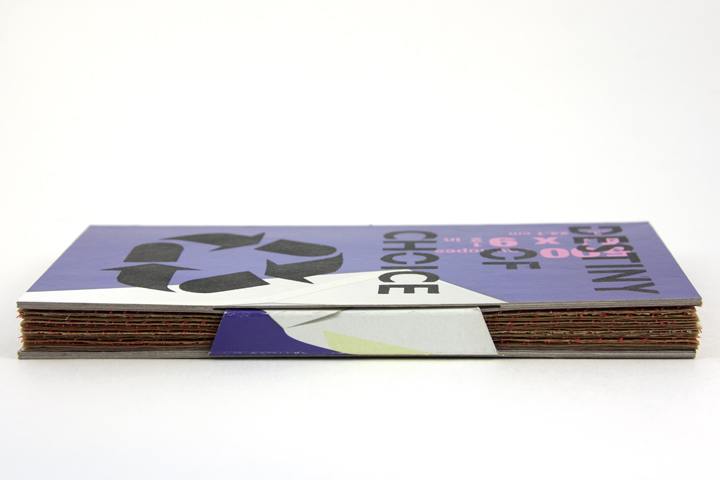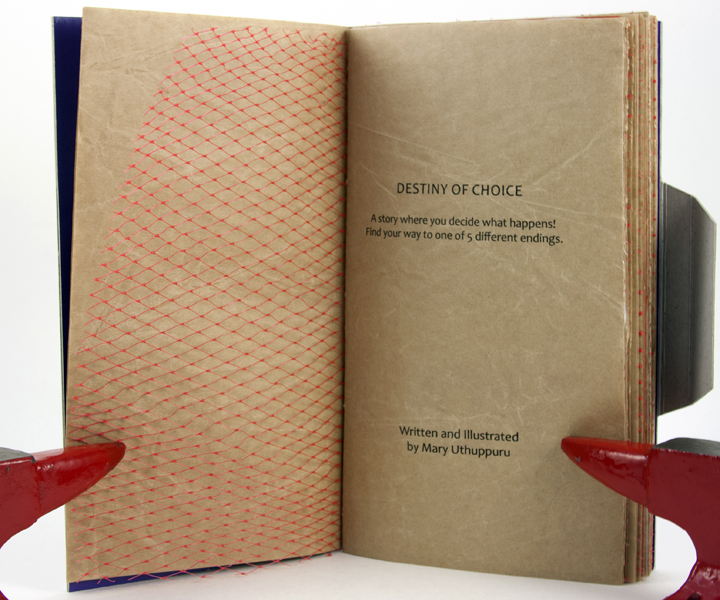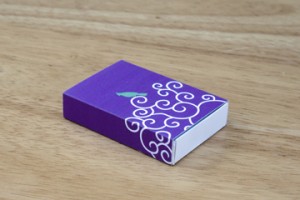Another of the books that was completed just at the end of August was an entry for the exhibit EcoEditions at 23SandyGallery in Portland, Oregon. The show runs November 15 – December 28, 2013 so if you are in the area, there is still time to see it! If you are not anywhere near Portland and would still like to see the show, you can see the online catalog.
The theme was fairly straightforward, as indicated by the title:
“EcoEditions asks the question: can books save the world? Can artist books raise consciousness, create awareness or change thinking? Let’s use our powers as stewards of the earth to report on the state of our environment, ecology, sustainability, pollution, climate, recycling and our planet in general.”
Content wasn’t too hard to come by for this topic. While many people who know me may not consider me an environmental activist, those who know me well are aware that I am adamant about reducing the amount of trash that I, and my household, produce. One of my goals is to leave as little of an impression as is possible on the natural world and the animals in it. This feeds my growing concern about global damage to the environment with careless living. I have a huge fixation with the excess of garbage that we generate, a lot of which comes from products whose sole purpose is to be used once and thrown away. Needless to say it was easy for me to identify which part of the “Eco” I would concentrate on.
The difficulty was deciding how my message of “be more conscious of the trash you make and how it can impact the natural world around us” would take shape. I know that many people do not respond to preaching and being told what they should do. It is a good way to get me to stop listening as well. So, after talking to a friend who always helps me creatively problem solve by allowing me to rattle on about the current undertaking, I found a format that would work. If you grew up and were of reading age in the 1980s, you may have heard of the Choose Your Own Adventure books. I loved these books and still own a few (and I just found out that they are still being made). This “choice” format was exactly what I wanted for my book. After all, what we do everyday is a choice, and we should be conscious of what the effects of those choices are.
 Readers follow a plastic bag*, the main character, and helps along on its journey after its usefulness is at an end. I made an edition of three Choose Your Own Adventure style books titled Destiny of Choice following suit with the epic titles I grew up with. The books are made from trash that came through my house. The only thing that was unused before it was added to the books was the dental floss that I used as sewing material. You’re welcome. Illustrations were drawn on the computer in Illustrator and inkjet printed on brown paper that came to me as packing material. Cut down to size and ironed, these pages contributed a nice “garbage” feel. I also interleaved various openings with plastic bags, plastic netting used for fruit, and a few other miscellaneous materials that I thought helped set the tone of the story. The title is hand stenciled on the cover which is made from old boxes that were headed for the recycling bin. The binding is in the Ethiopian style and each book has a slot and tab closure.
Readers follow a plastic bag*, the main character, and helps along on its journey after its usefulness is at an end. I made an edition of three Choose Your Own Adventure style books titled Destiny of Choice following suit with the epic titles I grew up with. The books are made from trash that came through my house. The only thing that was unused before it was added to the books was the dental floss that I used as sewing material. You’re welcome. Illustrations were drawn on the computer in Illustrator and inkjet printed on brown paper that came to me as packing material. Cut down to size and ironed, these pages contributed a nice “garbage” feel. I also interleaved various openings with plastic bags, plastic netting used for fruit, and a few other miscellaneous materials that I thought helped set the tone of the story. The title is hand stenciled on the cover which is made from old boxes that were headed for the recycling bin. The binding is in the Ethiopian style and each book has a slot and tab closure.
*Plastic is not the only hazard to our environment when it comes to garbage, but it is a very common item that comes through our houses and leaves without much notice. So it is a representative of the many things whose destinations deserve more consideration.
Conclusion
(As it appears at the end of Destiny of Choice)
How we live is a choice. I utilized the “Choose Your Own Adventure†format to address the decisions we make that contribute to garbage in our environment today. We don’t truly know exactly where things go once they are thrown away. To confront this, much interesting research is being done both privately and at institutional levels. Studies, like those at MIT, involve tracking pieces of trash with GPS devices in order to gain a better idea of where our garbage travels and how it gets from point A to B then sometimes back again. Studies like these will give a clearer picture about why things like trash islands, build up in the oceans.
What I really want people to come away with from this book is to think more about where refuse goes once it is thrown away. Because our focus is not always on the result of our daily actions, the idea that what we throw away could be harmful leaves our radar completely. After all, once our garbage is placed on the curb, it disappears like magic. No matter what, making less garbage is the best scenario, but when there is something that can’t be reused, where do you put it and what really happens after it leaves your possession?







